Battles at Legnitz and on the river Chaillot. Mongols in Eastern Europe
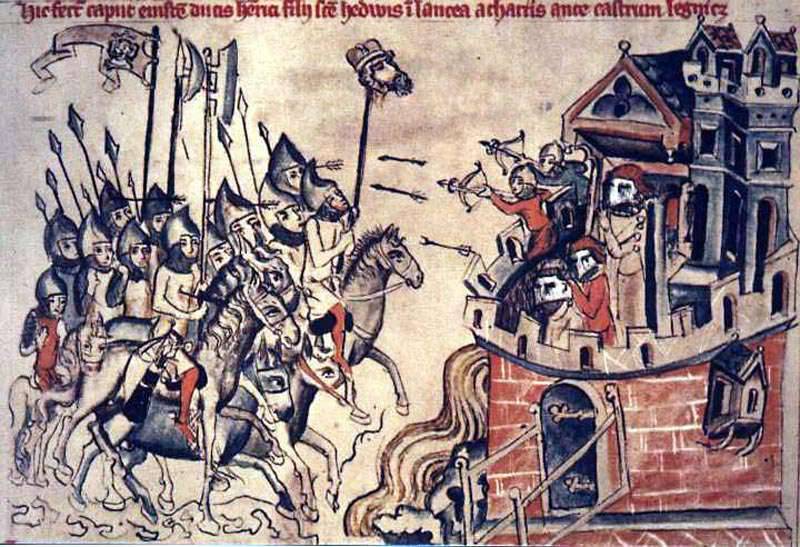
Europe at the beginning of the 13th century was largely ignorant of the new threat that was approaching it from the East. Information slowly arriving with caravans and travelers spread slowly. Europe itself, mired in chronic cruel feudal strife, was little interested in what was happening somewhere in distant lands — it would be to put things in order. The first data, very vague, about events in the distant steppes of Asia began to reach the courtyards of the monarchs in the 20-s. XIII century, when the army of Jebe and Subedey invaded the Polovtsian steppes. Having reached the limits of Rus suffering from princely strife, the troops of the Mongol Empire in 1223 defeated the Russian troops near the Kalka River and, taking large booty, migrated back to Central Asia.
Hungarian king Bela IV became the first of the European powers that be worried. He sent a Dominican monk Julian with several representatives of other monastic orders for the reconnaissance mission to the Volga region to deal with the situation on the spot. For three years, from 1235 to 1238, Julian collected information, which he successfully returned. The stories of a scout monk about the hordes of the steppe cavalry were so impressive and eloquent that they chose not to believe. While in Europe lazily waved away from the warning speeches of Julian, in the East it became again, to put it mildly, alarming. The huge army of Batu invaded Russia, and outlandish embassies began to appear at the courts of the sovereigns. The delegates, dressed in strange clothes, with slanting eyes and faces weathered by steppe winds, presented diplomas to local authorities. From these messages it followed that a certain person who calls himself the Great Khan, demands obedience and submission from kings and other rulers. Somewhere they were surprised by such arrogance, somewhere they laughed - in other places they were even disrespectful to the ambassadors, violating diplomatic etiquette, for the same Mongolians accused Bela IV of not returning several embassies from Hungary.
But after the ambassadors from the east, the refugees began to stretch - and they became less surprised, and stopped laughing altogether. In 1239, the Polovtsian Khan Kotyan addressed the Hungarian king with the request set out in the letter. Its essence was to ensure that Bela took on its territory Polovtsy fleeing from the invasion, in exchange for their acceptance of Catholicism. Prior to this, the Polovtsians professed a certain mixture of Orthodoxy and worship of the Turkic deity Tengri. In the autumn of 1239, Bela IV met Kotyan with almost 40 thousands of tribesmen at the border of his state and gave them permission to settle in Hungary. However, the local feudal nobility was frightened by the too great gain of royal power (before the absolutist “state is me” it was still more than four centuries) and arranged a conspiracy. On the eve of the Mongol invasion of Europe, in 1241, who converted to Catholicism, Kotyan and his family members were treacherously murdered in Pest. Polovtsi renounced Catholicism and migrated to the Balkans.
Nor was the alliance with the Hungarian kingdom of Russian principalities. Galician-Volynsk Prince Daniel Romanovich and Chernigovsky - Mikhail Vsevolodovich persistently sought this union. King Bela IV under various pretexts from any agreements evaded. There was no interest in the joint preventive curbing of the aggressor and other European states. The German Emperor Frederick II Staufen, an exquisite expert on languages and strategic intrigues, publicly joked Mongolian letters demanding submission - he modestly asked the Great Khan to appoint him a court falconer. In fact, according to some reports, he entered into secret correspondence with the Khan, intending to use this force in an ever-growing conflict with the Pope. The pontiff Gregory IX himself was obviously well aware of the threat from the East, for at that time the Catholic Church had perhaps the best agency in Europe. The pope had his own views on the Mongolian military machine, hoping to use it in the anti-Arab direction as an instrument of indirect action in the Middle East policy. In the north, the Livonian Order, which had an impressive military force, was preparing for an armed version of Catholicism in the Baltic States and northeastern Russia, and, focusing on the realization of their ambitions, showed no interest in confrontation with some Mongols. Neglecting the impending danger, which in its significance could not outweigh the traditional parochial feudal disassembly, cost Europeans dearly.
East vs. West
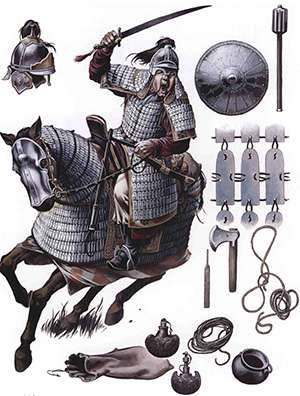
The military power of the Mongols was to some extent weakened by the stubborn resistance of the Russian principalities, but it was a significant force. When the Mongol khans were a sufficient number of scientists and geographers, so the command of the nomads was aware of the lands lying to the west of Russia, to a much greater extent than the Europeans knew about the newcomers from the east. Since the main blow was delivered to Hungary, we can assume that Batu planned to use the Hungarian valley as an operational and forage base in the center of Europe. Presumably, the general concept and plan for the raid on Eastern Europe was developed by Subedei, one of the best commanders of the Mongol Empire. He envisaged an invasion of Hungary from several directions in order to force the enemy to split up his forces, thereby reducing the level of resistance.
Three tumens (the main Mongolian tactical unit numbering 10 thousand soldiers) remained as an occupational contingent on the territory of Russia. Two Tumen under the command of the grandchildren of Genghis Khan Baidar and Kadan were to make a reconnaissance and sabotage raid in the north-west direction towards Poland. It was intended only to try the Poles for strength, to find out how capable the local troops were for defense, and then turn south to the main forces. With one tumen, the younger brother of Baty Shiban was to sneak around the northern edge of the Carpathian Mountains and enter Hungary from the north. Batu himself army, consisting of no less than four tumenov, struck through Transylvania, diverting attention, and the author of the plan Subedey, moving along the bank of the Danube, with the main forces was preparing to invade the kingdom from the south. Some researchers believe that the onslaught on Europe focused on Hungary, since Batu was only supposed to limit herself to it. Another version is that the defeat of Bela IV was only a stage on the path of further expansion. Try the Christian army to meet Batu or Subedei; in any case, it substituted its rear forces. The operation was well thought out.
The problem for the Europeans was also the fact that almost no one knew anything about the methods and methods of conducting military actions used by the Mongols. Of course, the term "Mongols" has a clearly collective character, since the army, which appeared at the beginning of 1241 near the walls of Europe, was a real international cocktail, which included representatives of various nations and nationalities. The avalanche that broke out of the boundless steppes of Mongolia, like a sponge, absorbed whole strata of various cultures. Together with them knowledge and skills were acquired. Those that were useful, were reworked and applied by conquerors in practice. European knighthood will have to face a completely unknown opponent, experienced, skilled, skilled and courageous. It was not a shapeless hoot mob of savages scattering when faced with a serious obstacle. A well-organized, prepared and, most importantly, experienced army was advancing towards Eastern Europe. She was bound by iron discipline, spilled blood in abundance, and the ruthless will of the khans. Countless victories with rare defeats contributed to the proper level of morale.
The main part of the Mongolian army consisted of cavalry - light and heavy. There were also elite units from the immediate protection of the commander, keshikten, a kind of guard. The main weapons Mongolian warrior was a composite bow of Yak horns and wood, length 130 – 150, see. The weapon had great power and range: arrows of length 90 – 95, could hit targets at a distance of about 300 meters, and at a closer distance were able to penetrate armor. Each warrior took with him a few bows and quivers to them - the whole rifle set was called Saadak. Heavy cavalry with warriors in armor, armed with swords, maces and shields, entered the battle at a decisive moment when light cavalry had exhausted the enemy properly, bringing him to an appropriate condition. Army personnel were divided according to the decimal system: ten, one hundred, one thousand and the largest tactical unit - tumen, consisting of ten thousand. The army was staffed at the rate of one warrior out of ten people. This rule extended initially to the ancestral Mongolian lands, and then, as they advanced, and to a part of the conquered. A rookie came to the service with his weapon and several horses. The Mongols were famous for their mastery of the siege and had a sufficient amount of equipment used in the assault on fortresses and cities.
Onslaught
At the very beginning of 1241, the Mongolian army invaded Poland according to the original plan. In January, they broke through to the Vistula, where Lublin and Zavikhost were captured and plundered. An attempt to hastily knit the local militia and knighthood to resist ended in the defeat of February 13 under the Turs. It was here that the Europeans for the first time experienced the Mongol tactics unprecedented before. The initial onslaught of the Poles was strong, and the light cavalry of the supposedly unorganized and wildish enemy began to retreat in complete frustration. Inspired by the chase, the pursuers, without even noticing it, turned into game surrounded on all sides and were killed. March 10 Baidar forced the Vistula at Sandomierz, after which, having isolated a detachment under the leadership of Kadan from his forces, sent him to destroy the region, he himself went to Krakow. The natural desire of the Poles to cover the Kraków area led to a new, larger-scale 18 March battle near Khmilnyk. This time Baidar was opposed by the Kraków voivode Vladimez Klemens and the Sandomierz contingent under the command of Pacosław. The Polish troops were demoralized even before the start of the battle by the actual desertion of Krakow prince Boleslav Shameful together with his mother, the Russian princess Gremislava Ingvarovna, and his family. Out of harmly, the prudent prince went to Hungary.
And again the Mongols showed themselves as the most skilled warriors. Since the Polish troops were concentrated in Krakow, it was decided to lure them out of there. A mobile group of light cavalry broke into the suburbs, arranged robberies and ruin there. The enraged Poles, seeing that there were few enemies, could not give up the temptation to rush in pursuit. The Mongolian detachment allowed it to pursue several tens of kilometers, skillfully without breaking the distance. After which the pursuers were surrounded by horse archers and exterminated. A lot of Lesser Poland died (Lesser Poland - historical region in southwestern Poland) chivalry and both governors. The remnants of the army dispersed, some of them ran to the city, causing a disorganizing confusion. Panic began to spread throughout the area. Krakow, left without defenders and almost without residents, was captured on March 22 and is already subject to thorough ruin.
Having finished with Krakow, Baidar moved on - Oder was waiting in front of him, which still had to be crossed - bridges and crossings were destroyed in advance. The construction and search for boats, rafts and other watercraft somewhat delayed the Mongolian army. By the time the vanguard of the Mongols appeared at Wroclaw, its inhabitants had already prepared for defense. The city itself was abandoned and partially burned, and the inhabitants, along with the garrison, took refuge in a well-fortified fortress. There were concentrated stocks of provisions in case of siege. An attempt to capture Wroclaw on the move failed - the defenders repelled the onslaught of the enemy with heavy losses for him. Not succeeding in a swift attack, the Mongols retreated to Baidar's main forces for regrouping. By this moment, the diversionary campaign of this northern group had already attracted too much attention. The local authorities, who only recently with obvious skepticism listened to stories about hordes of nomads sweeping away everything in their path and perceiving them as stories about the mythical kingdom of John Presbyter, now faced this disaster face to face. The enemy was no longer somewhere in the distance - he ruined the country. And a reaction, albeit belated, followed.
Battle of Legnica
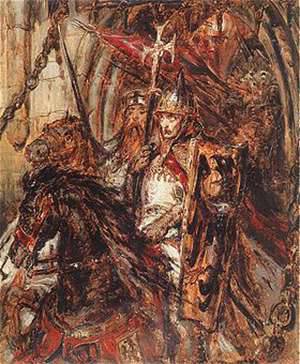
Prince Henry the Pious, recognizing the threat as very significant, began to assemble a large army. Troops moved from different places to it. The brother of the deceased Krakow voivode Sulislav with a detachment arrived from southern Poland. The contingent from Upper Silesia was commanded by Mieszko. Heinrich himself stood at the head of the Lower Silesian troops. The foreign forces in the combined army were under the command of Boleslav, the son of the Moravian margrave Dipold. Incidentally, there were members of the Templar Order. In any case, Grand Master Ponce d'Obon, in a letter to French King Louis IX, said that in the battle of Legnica, the Order lost about 500 people, of which 6 are knights. There was also a small detachment of knights of the Teutonic Order. The fact is that the father of Heinrich the Pious, Heinrich I the Bearded, transferred to the administration of this order a certain piece of land in exchange for help. Prince Heinrich appealed for help to his neighbor, the Czech King Wenceslas I, and he promised to send an army. Heinrich decided to try his luck in a field battle - his army, most of them infantry, had a large number of experienced warriors. Traditionally, a big stake was made on hitting a heavy knightly cavalry - in the European customs of warfare, this was one of the main axioms of victory. The difficulty of the situation was that it was not the Europeans who fought against Henry. He led his army to Legnica, a city in Silesia, where Vaclav I also moved, having decided to personally lead the army.
Baydar was just one day's walk from the city. Learning about Heinrich's approach and receiving information from well-placed intelligence about the threat of his unification with the Czechs, the Mongolian commander set out to meet the enemy in order to impose on him a battle and prevent the merging of the two armies. He informed about his decision with letters from Baty and continuing to repair the devastation in Mazadia Kadan.
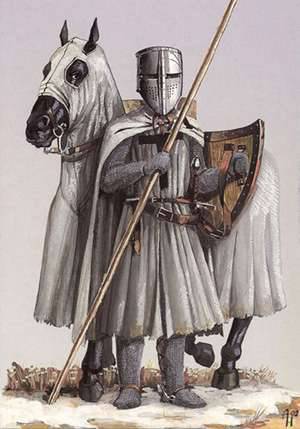
The forces of the opposing sides are generally comparable in number, but differ in composition. According to some reports, Baidar had 1 thousand skirmishers to worry and lure the enemy, 11 thousand horse archers and 8 thousand heavy cavalry. In total, his army is estimated at almost 20 thousand people. Heinrich and his allies could oppose this to 8 thousand heavy cavalry, 3 thousand light cavalry, 14 thousand infantry. Apparently, the Europeans were planning to repel the enemy attacks with their light cavalry, to bleed him, and then deliver a crushing blow to the heavy knightly cavalry.
Opponents met on 9 on April 1241 near Legnica. Baydar placed his skirmishers from the “luring group” in the center, on the flanks were horse archers. Heavy cavalry was stationed at some distance in the rear. Heinrich in front put his light cavalry, behind which the heavily armed horsemen stood behind the second echelon. The infantry was the third line. The battle began with the exchange of ridicule and insult, which was soon supplemented by mutual shelling from bows. The allies began to get more, so their light cavalry rushed to the already rather annoying skirmishers. However, successful at first, the attack began to blur - the enemy on his short horses drove away for some distance and continued to fire again, all the time keeping distance with the allies. Then Henry ordered heavy cavalry to enter the battle, which was immediately executed.
Encouraged by the avant-garde, regrouping, resumed the onslaught, and the Mongols, seeing the change in the situation, began to rapidly retreat, spreading along flank directions. The Allies began the pursuit of the seemingly fleeing enemy. And then the Mongols used one of their many unusual methods for Europeans: they made a smoke screen of pre-prepared bundles of wood, grass and brushwood. Puffs of smoke began to harbor the retreating skirmishers, and the entire cavalry armada of the Allies sped right through the clouds of smoke, seeing nothing around.
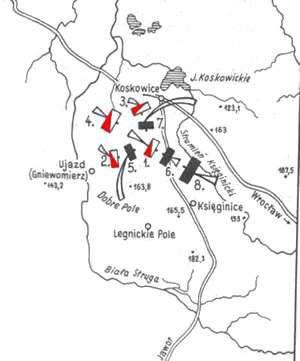
At this time, on the flanks of the horse archers began to surround the enemy's cavalry, generously showered her with arrows. When the inertia of the attacking knights was extinguished, completely fresh Mongolian heavy cavalry, hitherto in reserve, hit on them, exhausted by shelling and poorly oriented in the situation. Unable to withstand the onslaught, one of the Polish detachments attempted to flee, but only weakened the formation.
The blow of the Mongols recently turned the furiously advancing Europeans to flight. The infantry, seeing nothing because of the clouds of smoke and actually playing the role of extras, did not even suspect of an ever-increasing defeat. At last, running knights appeared and the Mongols who chased them tirelessly. This turned out to be a complete surprise - running horsemen crashed into the dense rows of their infantry, a landfill began, which quickly gave rise to panic. The system collapsed, and the Allied army ran, no longer representing the organized force. A real massacre began - the Mongols did not really need any prisoners. The rout was complete. He himself initiated the campaign Heinrich the Pious died in battle. Being late just a day to the battlefield, Vaclav, having learned about the defeat of an ally, preferred to retreat urgently. The killed soldiers of Baydar cut off their ears and put them into large bags, of which there were nine of them. The body of Prince Heinrich was decapitated, and his head impaled on the peak. With all these attributes of intimidation, the Mongols approached Legnica, demanding to surrender the city, but the residents, rightly deciding that it was better not to count on the mercy of such visitors, put up serious resistance and repulsed several attacks. Having ruined the neighborhood, the steppe inhabitants left.
Hungary. Battle of Chaillot
The information obtained by the monk Julian caused, of course, some skepticism, but the Hungarian king took certain measures to increase the country's defense capability. Some fortresses were reconstructed, stocks of weapons accumulated. When the Polovtsian Khan Kotyan granted his emigration together with his fellow tribesmen - and not because of the passion for travel, but because he was driven away from the native nomads by the Mongols, in Hungary they were alarmed not a little. The situation was complicated by the numerous and ambitious feudal nobility, who constantly intrigued against royal power and stubbornly did not want to strengthen the center, which resulted in the treacherous murder of Kotyan.
The first information about the appearance of the Mongols on the eastern outskirts of the court received in January. The king of Bela IV who was then in Pest entrusted Palatina (the highest official in Hungary before 1853 after the king) to Dionysius to set up outposts in the Carpathians. 10 March 1241 came the news of a large-scale invasion of a large Mongolian army through the so-called "Russian Gate" (Veretsky Pass). It was Batu with a whole staff of experienced military leaders - his army numbered tens of thousands of people. The conflict with the nobility, who dreamed that the royal army did not exceed the number of palace guards, did not allow time to push reinforcements to the border. On March 12, the limited forces of Dionysius were scattered, and the highly mobile enemy began to flood the country. Already on March 15, Batu's vanguard, under the command of his younger brother Shiban, reached the Pest district, where the king frantically assembled an army.
Baty who came up camped about 20 km from the main forces of the Hungarians. The nomads constantly kept the enemy in suspense with their presence, and in the meantime, flying units ravaged the neighborhood, gathering rich prey, provisions and fodder. 15 March they captured the city of Vats, a little later Eger. In the meantime, Bela's forces were increasing - considerable reinforcement in the person of the army of the Croatian duke Koloman approached him, and now their total number reached, according to various estimates, no less than 60 thousand people. Opinions on further actions caused controversy. Part of the leadership led by Archbishop Uholin of Kolochka required the most active actions. The zeal of the humble servant of the church was so great that he personally, without the approval of the king, made a sabotage attack on the Mongol camp with a couple thousand soldiers. There the bishop, of course, was ambushed and returned with only a few people. This initiative got away with him, because not everything was smooth at the headquarters of the Christian army: the vassal of Bela, the Austrian duke Friedrich Babenberg, quarreled with his overlord and departed to his homeland. Realizing that further inaction only loosened the army, and being confident of his superiority - now the king had 60 thousand against 30 thousand from Batu, - in early April, Bela ordered the combined army to come out of Pest. Not wanting to take the battle on conditions that were not favorable to them, the Mongols retreated. Overloaded by a convoy and a large proportion of infantry, the Hungarian-Croatian army slowly dragged after. A few days later, the main forces under the command of Subedei approached Batu: the Mongols had established excellent communications through the system of messengers, which allowed them to assemble an attack fist at the right time in the right place at the right time.
After a week of stalking, Bela camped by the river Chaillot. The camp was surrounded by a fence and wagons. On the left flank of the position was a bridge. For some reason the king decided that the enemy would not be able to force the river, and left only one thousand soldiers to cover it. Baty decided to surround the enemy and destroy it. He separated the corps of Subedei, who was ordered to secretly force the river to the south at night and go around the enemy camp. Khan himself spent the whole day on April 9 in a disturbing allied activity. On the one hand, he did not let them rest and kept them in suspense, on the other, the enemy saw that the Mongols had become much smaller, and cheered up, lowering their guard. April 10 passed in preparation for the operation.
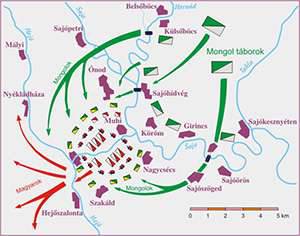
On the night from 10 to 11 in April, Subadei secretly forced Shayo under the plan and actually went to the allied army in the flank and rear. In the morning, widely using stone-guns, Batu successfully knocked down a barrier from the bridge and captured it. Soon the Mongolian cavalry surged through it to the other side. The news of the appearance of the enemy caught the Hungarians and Croats off guard. While the alarm was sounding, the steppe dwellers took convenient positions on the heights, showering arrows in the camp. Soon there were also stone throwers. By two o'clock in the afternoon, according to a contemporary of events, historian archdeacon Thomas Splitsky, the camp was tightly blocked by the Mongols, who massively used lighted arrows. Resistance began to weaken, and the army began to embrace panic. The flight of individual feudal lords with detachments began, and soon grew into utter chaos. Baty prudently did not completely encircle the enemy, leaving him a small loophole, otherwise the allies could start to fight to the death, and then his army would have suffered completely in vain losses.
The Mongols were masters of not only tactical retreat, but also knew how to competently and stubbornly pursue the enemy. The crowd, a few hours ago, the former army, which had lost everything - from the fighting spirit to the banners and the wagon train - were now being driven towards Pest, from where it had only recently come out. On the shoulders of the running Mongols broke into Pest. The city was looted and burned. The rout was complete. Losses of Hungarians and Croats are estimated at more than 50 thousand people. The kingdom lost not only the army, but also the king. Bela IV found no other way but to flee to his vassal, the Austrian duke Frederick Babenberg. The demoralized king gave him for his help in the fight against the invasion and, probably, for providing asylum almost all the treasury (10 thousand marks) and three counties. The seriously wounded Duke Koloman with the remnants of his unit retreated to Croatia.
Unfinished campaign
The Mongol detachments, almost without meeting resistance, continued the unimpeded devastation of the country. The greatest advance of the Mongols to the west was recorded in the spring of 1242, when the Tumen of Kadan, capturing the city and the fortress along the way, reached the Adriatic. Batu himself with Baidar, who approached him from Poland, took up the devastation of the Czech Republic. And then the steppe was taken and looted many cities. Caught in the forced emigration, Bela IV tried to raise the resonance due to the extreme plight of his state, and indeed of all of Eastern Europe. He sent letters asking for help to two of the most powerful figures of that time: the German Emperor Frederick Staufen and Pope Gregory IX. Naturally, absorbed in exploring the relationship between themselves, these politicians had nothing to do with the moans of the Hungarian king. The emperor responded sympathetically that, say, the Mongols were very bad, and the Pope cited concerns, confining himself to words of support and comfort. Austrian hospitality soon dried up too, and Bela was forced to flee to Dalmatia. It is not known how events would have happened further if, at the end of 1241, Batu did not receive an emergency message about the death of Great Khan Ugedei. Now, the highest Mongol nobility were to gather at the kurultai in order to elect a new ruler of the colossal empire. The activity of the Mongols in Europe is gradually decreasing. Despite the activities of individual, even large, detachments, a gradual departure to the East begins. There are several versions of the termination of the campaign against the West, and one of them is that the death of Ogedei was only a reason for the retreat of the army, worn out by the battles and heavy losses incurred in the struggle against the Russian principalities in Eastern Europe. Perhaps there were plans for a repetition of such a campaign for the future, but in the light of more and more civil strife covering the Mongolian empire, this plan was not implemented.
Shortly after the departure of the aggressors, King Bela IV returned safely to his official duties and did much to strengthen the royal power. Already in 1242, he made an army against the duke of Austria, forcing him to give the county actually taken from the Hungarians. Batu, or Batu-han, settled in the capital of his ulus Saray-Batu, actively participating in the political life of the Mongolian state. He no longer made any military campaigns to the West and died in 1255 or 1256. Europe, frozen in a fit of horror before the hordes of impetuous steppe nomads, after their departure, took a deep breath and engaged in the usual routine feudal squabbles. The vast lands of Russia stretching to the east were waiting for hard, tragic times full of blood, the grass of Kulikovo Field covered with blood and the frozen banks of the Ugra River.
Information